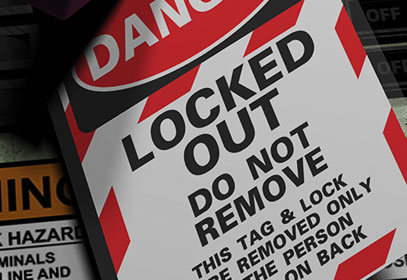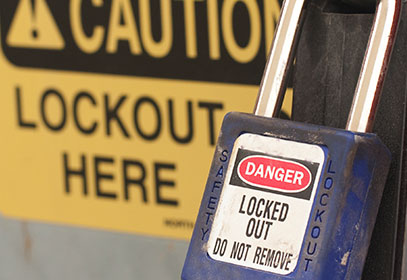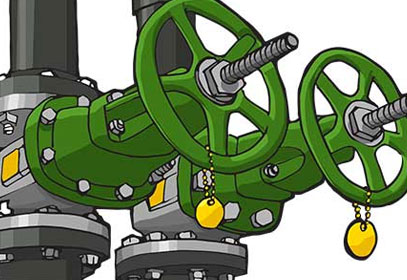Resources
Did you know OSHA’s standard for controlling hazardous energy (lockout/tagout) is consistently one of the agency’s top ten most frequently cited standards? Year after year, compliance officers are finding improper LOTO procedures, misused devices, and no documentation in facilities across the country. In order to ensure safety and avoid hefty penalties, employers need to prioritize lockout/tagout.
The unexpected energization or release of stored hazardous energy, including electrical, mechanical, hydraulic, pneumatic, chemical, and thermal energy, has the potential to cause serious injury or death during servicing or maintenance operations if proper lockout/tagout practices are not being followed.
Staying compliant with OSHA means meeting the required components of lockout/tagout:
- Procedures: OSHA provides the basic framework for LOTO procedures, but specific procedures will vary facility to facility. Employers must keep a documented copy of specific action and procedures for controlling hazardous energy and are responsible for enforcing the facility’s policy.
- Training: Training is required for employees authorized to complete lockout/tagout procedures and for affected employees working in the area where energy is controlled. Authorized workers should know how to shut down equipment, isolate it from energy sources, and prevent the release of hazardous energy.
- Devices: Lockout/tagout devices are different depending on the equipment being serviced or repaired. Lockout devices are typically either a combination or key type, and when those cannot be used, a tag is securely fastened to the equipment.
- Auditing: Organizations are required to inspect their LOTO procedures every 12 months; conducting annual audits will keep you compliant and reveal any inconsistencies or issues with the program.
OSHA estimates lockout/tagout compliance prevents over 100 deaths and tens of thousands of injuries every year. Whether you need to refresh your LOTO program or are planning to implement new lockout/tagout practices, Creative Safety Supply is here to help you meet compliance.
Getting Started
- Confused with terminology? Check out our safety glossary.
- Want to learn more about electrical hazards? Explore our electrical safety resources.
- Have a question about LOTO? Browse our lockout/tagout Q&A hub.
- Ready to get started? Shop our selection of lockout/tagout supplies.
Lockout Tagout Articles
Typical Lockout Tagout Procedures
Find out how to use lockout tagout procedures for different kinds of energy including electrical, chemical, and pneumatic. …
Lockout/Tagout Program (How To Control Hazardous Energy)
Understand the basic requirements for preventing the accidental startup of equipment during maintenance. …
Valve Tags: Guide for Pipe Identification
Tips and recommendations for labeling the valves on your pipe system. …
Lockout Tagout Questions and Answers
Who is responsible for the lockout/tagout program?
Lockout/tagout (LOTO) is a type of energy control program that protects workers from getting injured by a sudden start-up of a machine or by the release of hazardous energy when performing maintenance activities. Employers are in charge of of developing a lockout/tagout program to prevent the unexpected release of hazardous energy. As it is required by… …
What does LOTO stand for?
LOTO, known in the working world as Lockout/Tagout, is a vital safety strategy used to protect a facility’s workers from being harmed by hazardous energy. Hazardous energy is defined as the potential stored energy in equipment that may suddenly be released when workers are servicing equipment. This type of energy can be expressed electrically, chemically,… …
How does lockout/tagout improve safety?
The lockout/tagout program is one of the most important safety improvement strategies used in workplaces today. It is a relatively simple system that has helped to save many people’s lives, and prevent even more injuries, over the years. Understanding how lockout/tagout improves safety will show why it is so important to implement in the workplace. Cutting… …
What other tools should be used in a lockout/tagout strategy?
When planning a lockout/tagout strategy you need to make sure you have everything in place to ensure the system is successful. One of the best things about the LOTO program is that it is quite easy and affordable to implement, so any business can do it. When done properly, the strategy will also help to… …
What makes a lockout/tagout program effective?
Implementing a lockout/tagout program is a great way to improve safety in any facility. In many cases, it is even required to remain compliant with OSHA regulations. After implementing this type of program, however, you will also need to know how effective it is so you can make adjustments as needed. Knowing what makes a… …
Is PPE required for lockout/tagout?
Workplace safety is an important responsibility of every employer. When there are serious hazards that can cause permanent injuries or even death, it is especially critical to take it seriously. In many cases there are multiple different steps that can be taken to reduce the hazards of a given environment. For example, using a lockout/tagout… …
What are machine-specific lockout/tagout procedures?
Lockout/tagout (LOTO) is a program that physically removes the sources of power to a machine, locks them out, and has a tag in place that indicates why the power was removed. This is a safety procedure that is used whenever someone is working in or around a dangerous area of a machine to ensure it… …
What types of hazardous energy can a lockout/tagout program control?
There are many types of energy that are used in manufacturing and other areas today. Whenever working on machines, it is important to isolate and control all types of hazardous energy that could potentially power the machine or cause other issues. The lockout/tagout system is designed to remove all sources of energy from machinery before… …
Why is lockout/tagout important?
The lockout/tagout (LOTO) program is one of the best known and most important safety procedures used today. It has helped to prevent a large number of deaths, and even more injuries, over the past several decades. While it is very simple as far as how it works, its effects are far reaching and proven to… …
Where should lockout/tagout tags be placed?
Lockout/tagout (LOTO) are used to physically prevent systems from reengaging while someone is working on or in a machine. The system ensures that when power is physically removed from a machine it will be prevented from being restored by anyone other than the person who is performing the work. This has helped to reduce the… …
Is lockout/tagout required by OSHA?
It is well-known that the lockout/tagout system is will help to improve safety in the workplace. According to the latest statistics, using lockout/tagout has saved hundreds of lives and prevented thousands of injuries since it has been widely used in manufacturing and other industries. While the fact that it is so effective should be reason… …
When should lockout/tagout be used?
A good lockout/tagout (LOTO) program should be used to help protect employees, contractors, vendors, and others from the dangers of working in and around dangerous machinery. Any time someone is going to enter into a machine or a hazardous area, the power should be removed and locked out so that the machine can’t be accidentally… …
What is a LOTO procedure?
There are many hazardous situations that take place in in manufacturing and other facilities. For certain particularly common or serious situations like this, it becomes necessary to implement a specialized procedure designed specifically to address a problem. In 1989, OSHA made the lockout/tagout (LOTO) procedure mandatory for companies operating in the United States. Even prior… …
What is a LOTO station?
When it comes to implementing the lockout/tagout program in a facility, nothing makes it easier or more effective than a LOTO station. This is a simple place where you can store all the various components of the LOTO program so that they are all easy to find whenever you need them. In addition, this type… …
Why should a facility implement a LOTO program?
When managing a workplace, it is important to do everything possible to ensure the safety of employees and the facility itself. There are many different programs and strategies that can be used in this area, so choosing the right ones for a given situation can be difficult. When it comes to minimizing the hazards of… …
Who benefits from LOTO?
The lockout/tagout program is designed to help improve safety in a facility. When implemented correctly, it can help to dramatically reduce the risk that someone or something will be in danger when working in or around machinery. This can include protections from being crushed, hit by moving parts, electrocuted, cut, or experience other types of… …
What are LOTO devices?
When using the lockout/tagout procedure it is necessary to place a physical device on either the electrical supply cord, or the place where the machinery in question is plugged in. These are the items that will stop other people from inadvertently energize a machine, putting the person in or around it in danger. There are… …
What are LOTO tags?
In the lockout/tagout procedure, the person who is working in a potentially dangerous area will need to attach a tag to the lock that they are putting on the power cord or other power supply. This tag is where the procedure gets the second half (tag out) of its name. Understanding what a LOTO tag… …
What are some examples of a LOTO procedure?
There are many situations where the lockout/tagout (LOTO) procedure can be used to improve safety in the workplace. Each facility is going to have a different set of situations where the LOTO program should be used. In order to know when it is necessary to use this type of safety procedure, it can be helpful… …
What is the main goal for a LOTO program?
The main goal for a lockout/tagout (LOTO) program is to improve the safety of employees who work on potentially dangerous machines. Specifically, it will prevent a machine from being powered up while workers are performing maintenance in a potentially hazardous area. The concepts behind the LOTO program are quite simple, but they have been proven… …
What is a Lockout/Tagout (LOTO) program?
The lockout/tagout (LOTO) program was developed to help protect workers who are performing maintenance on machinery from getting hurt due to the unintended startup of a machine. OSHA requires facilities to have safe de-energization practices and a LOTO program that is tailored specifically to their environment. In general, however, the steps taken will be quite… …
















